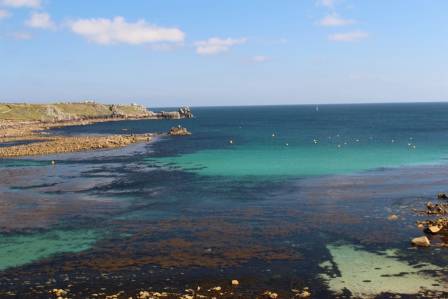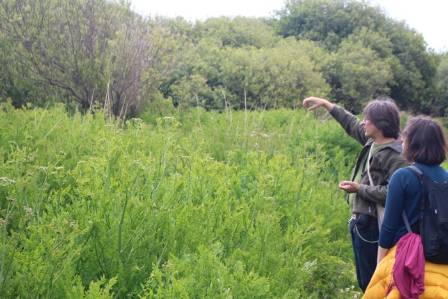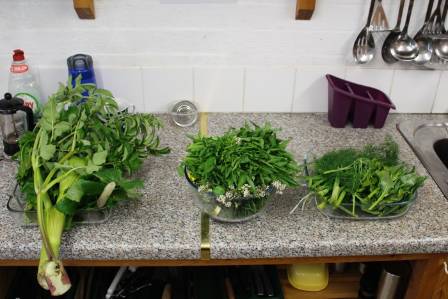I am very happy to reveal that I have now finally had success with obtaining some decent specimens. Over the past three days myself and various assistants have used a variety of methods (seine nets, fishing rods, hands) on three different islands (St Mary's, St Agnes and Bryher) and have collected at least 16 different species of fish. It's hard to say for for sure exactly how many until I can get back to the Museum and look at some of them under a microscope.
Most of them are on the list of fishes I made before I left but there are a few which will be new records for our collection from this locality. It's been a great pleasure to meet naturalist and local legend Rosemary Parslow, who collected most of our Scillonian fish specimens back in the 1970s and compare notes and get some advice about where to get certain species.
On Friday, despite grim weather conditions, we headed down to Porth Hellick on the southern side of St Mary's. At this point all I had to show was one baby sandeel so my joy was unconfined when our first drag of the seine net through a large rock pool produced tens of little bodies flopping about. Most of these were sand gobies - some of the fattest I've ever seen - but there were also some juvenile flatfish.
Fat sand gobies (Pomatoschistus minutus)
A few more drags produced some other species of goby and a very dark looking shanny.
Shanny (Lipophrys pholis)
The best find of the day for me was a worm pipefish which I found underneath a rock. These are not very fast swimmers but are hard to spot as they look just like a bit of seaweed. A closer look at the specimen revealed something interesting, a cluster of orange eggs stuck to the belly of the fish indicating that this was a male specimen.
Pipefishes are in the same family as seahorses (syngnathidae), and like them, the male takes care of the eggs after they have been laid by the female. I felt a bit guilty taking this specimen but I had never seen one like this before. I should point out that all the fish I collect are anaesthetised using clove oil before preservation so the process is as painless as possible (this also makes for nicer looking specimens).
Male worm pipefish (Nerophis lumbriciformis) with eggs
The following day the weather had improved vastly and we boarded a boat for St Agnes, the island to the south of St Mary's. Rosemary had recommended a particular bay called Porth Killier so we headed there full of optimism. Upon looking at it my heart fell slightly as the whole area was thickly blanketed in various kinds of seaweed - lots of places for fish to escape and tricky to use the seine. Nevertheless, Tom and I carefully ventured forth and after about half an hour of rummaging about in the kelp I found my first ever clingfish!
Porth Killier, St Agnes
Sadly this escaped a bit later due to an incident with the bucket and I did my best to be philosophical about this. We got some more pipefish and some rock gobies so all was not lost but then Tom developed some kind of clingfish sixth sense and within half an hour or so we had seven specimens of two different species (shore clingfish and small-headed clingfish).
Shore clingfish (Lepadogaster lepadogaster)
Two rock gobies (Gobius paganellus) and a small-headed clingfish (Apletodon dentatus)
If there's one thing I have really got out of this trip it's a greater appreciation of other people's specialities. Suddenly I find myself looking at flies and plants and shellfish in a whole new way (one of the other nice results from our trip to St Agnes were the discoveries of blue-rayed limpets and spotted cowries in the kelp). But in particular crabs.
Previously I thought there were shore crabs (the browny-green ones) and edible crabs (the pinky-purple ones) and that was probably about it, but my crab universe has now expanded exponentially. On St Agnes I found what I think were five or six different species, some of which were relatively benign when disturbed, some of which were furious. Every rock we turned over also revealed a wealth of fascinating creatures, and at times I almost forgot about fish.
A strange crab
Returning home triumphant we decided to round off the day with a spot of fishing at Penninis Head. This was initially extremely successful and I caught a nice big ballan wrasse on a fishing rod that telescopes into something the size of a pen and Tom got a fine pollock. Although both of these are edible (although opinions vary about the wrasse) the national collection trumps our stomachs and they were placed in the freezer when we got back. I have never before seen the attractive blue inner lips of the ballan wrasse, another first for our trip.
Ballan wrasse (Labrus bergylta)
The blue inner lips of the ballan wrasse
I'm afraid I have now run out of time and I think the limpet risotto is just about ready. More soon and I will leave you with this, one of the black rabbits - descended from escaped pets - that live just outside our bunker.
Black rabbit of St Mary's



.jpg)



